MSI GT627: Bringing Balance to the Force?
by Jarred Walton on April 29, 2009 4:00 AM EST- Posted in
- Laptops
Battery Testing - we need Hybrid Power, please!
For battery life testing, we run all laptops at around 100 nits brightness. If you choose to run your LCD at maximum brightness, you may lose 10 to 60 minutes depending on the laptop and the display. In the case of the GT627, maximum brightness is ~190 nits and uses just 1W more power, so the impact on battery life is generally small (see the idle chart below for reference).
We run several different battery life scenarios: Internet surfing (load several webpages using the wireless adapter every minute until the battery dies), DVD playback, x264 playback, and idle (maximum) battery life. For x264 playback, we copy a 720p file to the hard drive and loop playback using Windows Media Player Classic Home Cinema; we will include scores from other laptops, but it's worth noting that we did not have GPU accelerated x264 decoding enabled in earlier laptop tests. We've also included web surfing results (and DVD for the MacBook Pro) for the latest Apple MacBooks as a point of reference.
Several systems that we've tested include extended capacity batteries or a second battery, so we've colored those results light blue. The Alienware m15x has two batteries in addition to letting you disable the discrete 8800M GPU and run on the integrated X3100 graphics, so we colored the IGP results gold/yellow. Using the IGP cuts power requirements by about 20W at idle (and over 60W at load), which dramatically changes the m15x X3100 placement in these charts. We really wish more manufacturers would offer such a feature, especially with high-end GPUs.
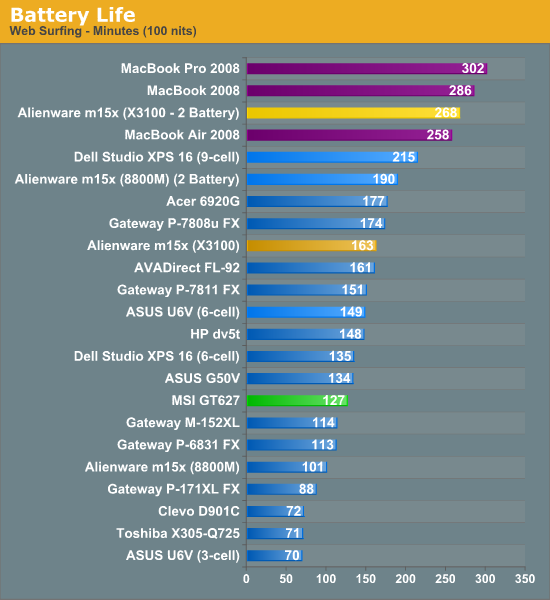
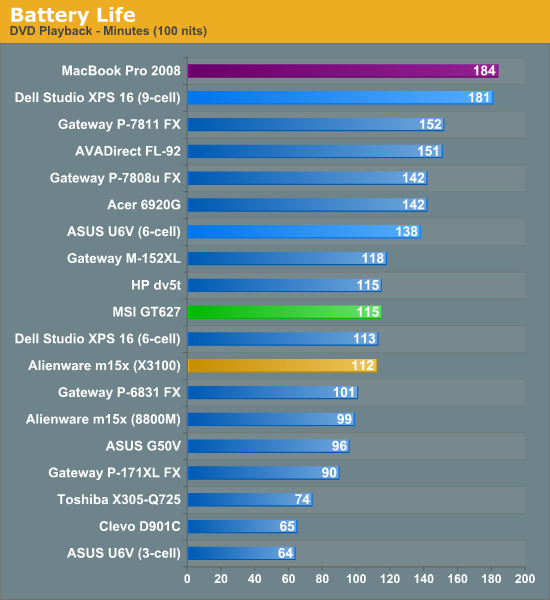
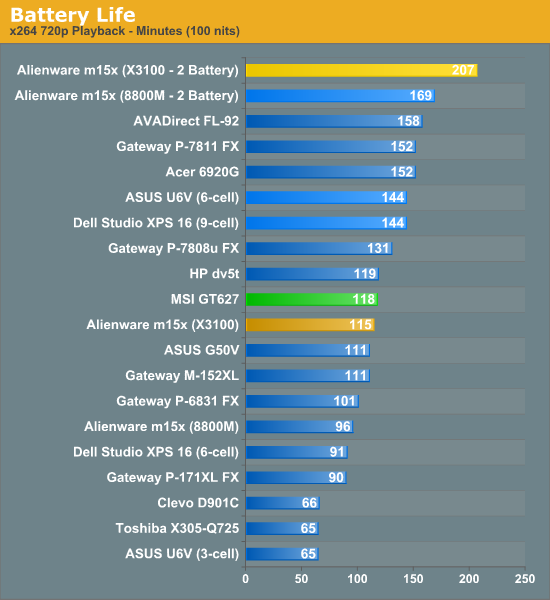
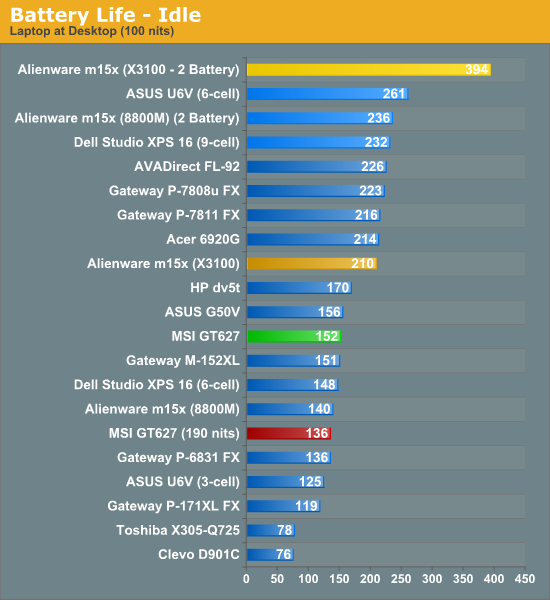
Battery life is generally unimpressive, hovering around the two-hour mark. In a best-case scenario - i.e. doing absolutely nothing - the MSI GT627 manages 2.5 hours of battery life. We didn't really expect much more than this, considering this is a moderate gaming laptop with a 6-cell battery. We can only wonder what might have been if MSI included an integrated graphics solution and supported NVIDIA's Hybrid Power feature. That should reduce power requirements by 5W to 10W at idle, which could result in a 50% (or more) improvement in battery life. Consider, the difference between maximum brightness and 100 nits is only 1W, and yet battery life improves by 16 minutes in the idle chart. If we could shut off the discrete graphics chip and save 5W, we would get about 3.25 hours of battery life, and 7.5W saved would give us nearly 4 hours. There is simply no good reason why users can't buy a reasonably priced gaming notebook and still be able to use it for three or four hours without plugging in. If it added $100 to the price of the notebook, I would be more than happy to pay that extra money rather than spending $100 on a second battery.
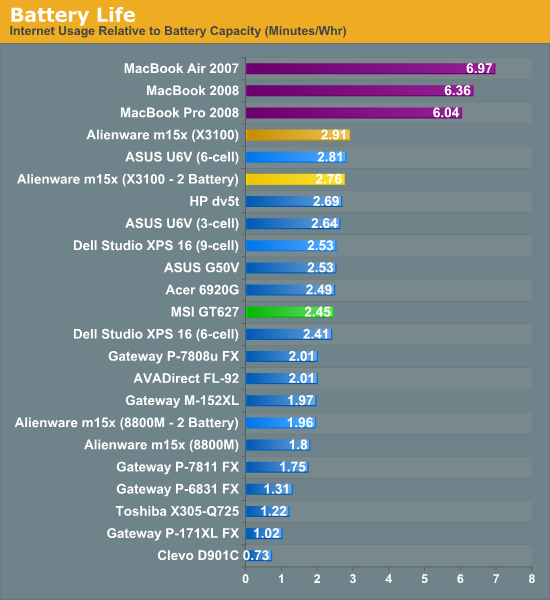
In our apples-to-apples - or Apples-to-PCs - comparison, where we look at battery life relative to battery capacity, we continue to see the tremendous advantage Apple enjoys by controlling both the hardware and operating system. Hopefully things will improve once Windows 7 starts shipping, though we're definitely not holding our breath. We think it's far more likely that notebook manufacturers just need to spend more time optimizing for battery life, as windows XP wasn't noticeably better than Windows Vista in this area.










47 Comments
View All Comments
fwacct4 - Saturday, May 2, 2009 - link
I'm glad noise has been evaluated in this laptop review as well. Lots of stuff on desktop noise, but since I can't stick a laptop in a closet and still run it, fan noise on a laptop distracts me like nothing else. Even worse are laptop fan noise coming from people sitting near me.Rolling Camel - Friday, May 1, 2009 - link
I'm really looking forward to a GT725, it is the uber notebook below $2000, not Gateway. My A64 3000+ is really slow and i need a computer with enough graphics power. So either i get an Phenom 2 X3 and Hd4870 based system, or get the GT725. The desktop is cheaper and more powerful, but i need mobility for my school.I know the GT725 has some worries:
1.The keyboard, although there is a solution for it.
2.Many report that the track pad wears fast, as if i will ever use.
3.I'm worried about the thermal dissipation. The R770 seems more fit for the task.
4.Warranty and customer service.
The HD4670 equipped EX 625 is very tempting with it's $750 price tag.
ira176 - Friday, May 1, 2009 - link
Apple's batteries are custom made lithium polymer. They are not typical run of the mill lithium ion cells that most manufacturers use. Apple's batteries use all of the space in their design and have no "dead" space due to round cells packed in a rectangular battery as most win pc notebooks have. Although Apple's OS may be a little more conservative on battery usage it's got to be the mere fact that there's more capacity in their battery design, and maybe even cherry picked hardware and LED lcd displays. Win pc's could probably see better battery life with better battery designs and better part choices. Of course we would pay more for that pc notebook.JarredWalton - Friday, May 1, 2009 - link
Apples batteries are rated at between 40 Whr and 50 Whr in the current models - 40 for the Air, 45 for the standard MacBook, and 50 for the Pro if I'm not mistaken. The construction and material used in a battery does not affect the rating in Whr. If something is designed to output 5200 mA at 9.6V, it is a 50 Whr battery. A lithium polymer might be lighter for the total capacity, but I'm not talking about capacity.Given the above, it means that Apple's standard MacBook apparently consumes around 9.4W when surfing the Internet. In contrast, the ASUS U6V eats up 21W on average for the same task. I'm hoping to get a MacBook for a bit just to make sure there's nothing else going on, but Apple apparently uses less power surfing than most Vista PCs use at idle.
Zan Lynx - Friday, May 1, 2009 - link
From what I've gathered about it, Apple "cheats." They can turn hardware on and off and do clock scaling that isn't available via ACPI.JarredWalton - Friday, May 1, 2009 - link
Lenovo indicated to me at CES that they actually turn off components that aren't in use, which is how they improve battery life (supposedly - still waiting for a test sample). It makes sense that if your optical drive is inactive, completely shutting off power makes more sense than a .5W sleep state. They said they also power off the speakers when the sound is muted or when headphones are connected (another few hundred mW). I don't know about other devices, but really I don't care if it's "cheating" - custom designed hardware that functions better than the competition is fine as long as it works properly. Windows 7 is supposed to enable some better power savings (up to 11% better battery life I've heard), so we'll see.The0ne - Thursday, April 30, 2009 - link
If you're going to game on it why not just get one with 17" LCD? Better yet, get one with 1900x1200 and everything is just beautiful :)It's great that the article addresses the LCD issues. I mean come on, it's one of the main components when considering a laptop.
Rob94hawk - Thursday, April 30, 2009 - link
Where is this Clevo901c laptop?JarredWalton - Thursday, April 30, 2009 - link
I'm not sure what you mean. Do you mean where are the specs? If that's your question, the Sager NP9262 is a Clevo D901C chassis. Several other companies (WidowPC, AVADirect, Eurocom, etc.) use the Clevo chassis and rebrand it as their own, so I figured listing the original manufacturer in that case made the most sense.GoatMonkey - Wednesday, April 29, 2009 - link
The display on the MSI GT627 218US is apparently different, because it is listing max resolution of 1680x1050. I'd like to know if that display has better contrast ratio.Also, any news on the upcoming MSI GT628 with the nVidia M160?